Soyuz-5 Launch Vehicle
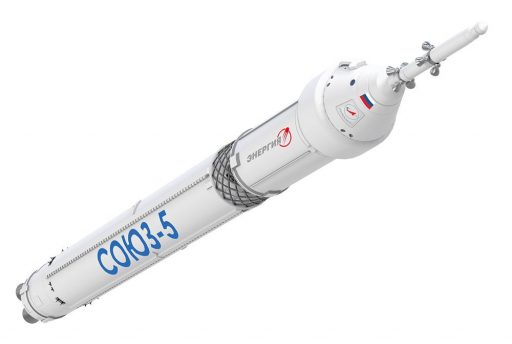
Soyuz-5, also known as Feniks and Sunkar, is a planned Russian Orbital Launch System envisioned to become Russia’s future workhorse for crewed exploration flights and orbital logistics as a replacement for the Soyuz and Zenit rockets while also building the foundation for a future Super Heavy-Lift Launch Vehicle.
Advancing from preliminary design work into in-depth design and fabrication in 2018, Soyuz-5 appears to be the most serious attempt at getting a Soyuz replacement off the drawing board and to the launch pad.
Soyuz-5, although sharing the name with the undisputed workhorse of the Russian space program, will be very different and only share a very distant lineage with the vehicle that powered Russia’s space ambitions from the dawn of the Space Age. In design, Soyuz-5 can be considered a 21st century copy of the Russian-Ukrainian Zenit rocket relying on an all-Russian design and implementing some performance enhancements to create a vehicle with sufficient power for lifting Russia’s future crew vehicle, Federatsia.
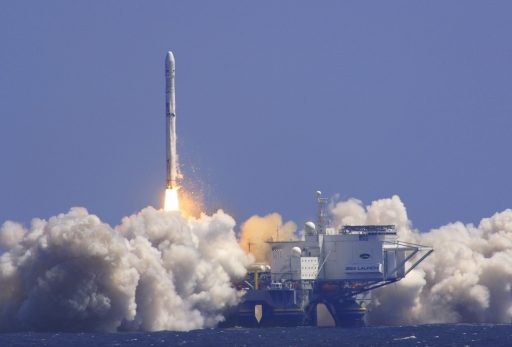
As a medium-class launch vehicle, Soyuz-5 is hoped to become a multi-tool of the Russian space program – covering the whole spectrum of launches from crewed missions with Federatsia, lifting lighter space station modules, launching civilian & military satellites and becoming a competitor on the commercial market with a per-launch-price rivaling that of the re-usable Falcon 9. All this is to be accomplished by banking on an adapted version of a proven design, use of high-performance engines and modern manufacturing techniques such as 3D printing.
Specifics on the Soyuz-5 as an All-Russian, 21st Century Zenit rocket first emerged in December 2015 after Russia’s evolving launch vehicle plans took a turn from developing a methane-fueled Soyuz replacement to a more-powerful Zenit-based vehicle retaining the tried and true Kerosene-Liquid Oxygen propellant combination. This decision was made after Russian leadership around President Putin urged Roscosmos to move in this particular direction after much of the 2010s were spent working out a firm path toward replacing the Soyuz/Soyuz launch vehicle and spacecraft combination.
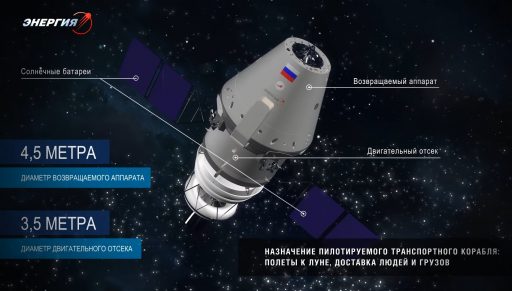
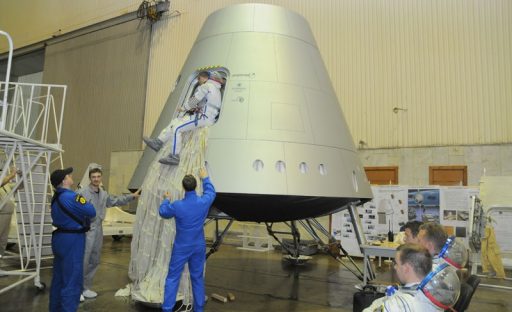
What would eventually become Soyuz 5 had been on paper at Russian spacecraft and rocket builder RSC Energia since the 2010/11 time frame. The concept, then going by the name Sunkar, had been floated numerous times and when Roscosmos began shopping for new rockets, Energia was able to provide an advanced proposal for an all-Russian rocket.
The pace of work on the proposed Sunkar vehicle picked up in 2017 after a meeting between Russian space officials and Putin that coordinated the decision to move the upcoming PTK Federatsia crew spacecraft from a modified version of Russia’s Angara rocket to Sunkar, representing a firm commitment to the vehicle. As the vehicle gained political significance through its new role in Russia’s crewed space program, it was re-christened Soyuz-5.
This decision also firmed up a controversial proposal of making Baikonur the base of the crewed Soyuz-5, taking a step away from the Vostochny launch site in Russia’s Far East.
Under leadership by RSC Energia, serving as prime contractor for the program, Soyuz-5 was accelerated through the preliminary design stage in 2017 with design reviews in early 2018 involving Russian research institutes, industry and military certification institutes.
The preliminary design of the Soyuz-5 was submitted to Roscosmos by the end of March 2018 and presented to the public the following April.
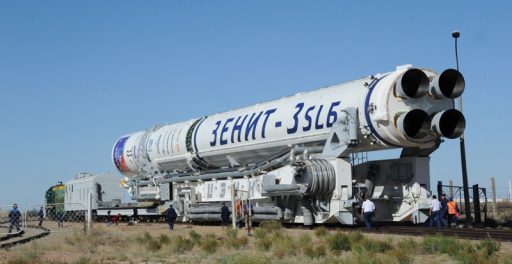
All specifications presented on this page are based on the preliminary design document or other documentation obtained from the preliminary design stage and are therefore subject to change as Soyuz-5 proceeds into detailed design studies and initial fabrication.
The Soyuz-5 medium-class orbital launch vehicle is a two-stage carrier rocket with a Low Earth Orbit performance of 18 metric tons. The addition of an optional third stage will enable the rocket to carry out deliveries into virtually all orbital regimes with a performance to Geostationary Transfer Orbit in excess of five metric tons and direct-to-GEO capacity of 2.5 metric tons when launching from the Baikonur Cosmodrome.
Soyuz-5 Design
| Type | Soyuz-5 |
| Prime Contractor | RSC Energia |
| Height | 61.87 m |
| Diameter | 4.1 m |
| Launch Mass | Approx. 530,000 kg |
| Stages | 2 + Upper Stage (RB) |
| Boosters | None |
| Mass to LEO | 17,000 kg |
| Mass to GTO | >5,000 kg |
| Mass to GEO | >2,500 kg |
The core objective of the Soyuz-5 launch vehicle is the creation of an all-Russian launcher based on proven hardware and design from the Zenit program while introducing modifications such as the use of modern-day manufacturing techniques and slight design changes intended to increase the new rocket’s performance over that of Zent. The result is a two-stage Liquid Oxygen/Kerosene rocket powered by a single RD-171MV engine on its first stage and a pair of multi-chamber RD-0124M engines on the second stage; plus the option of adding different upper stages for high-energy deliveries.
Soyuz-5 stands 61.87 meters tall (65.9 meters when flying with the PTK Federatsia) and measures 4.1 meters in diameter with a launch mass of 530 metric tons. Both stages of the rocket consume Rocket Propellant 1 (rocket-grade Kerosene) and Liquid Oxygen as propellants, employing a four-chamber RD-171MV engine on the first stage while the second stage is powered by two four-chamber RD-0124M engines. Common in Russian rocketry, the stages are connected by a lattice structure, enabling a hot-staging technique to be employed by the two main stages.
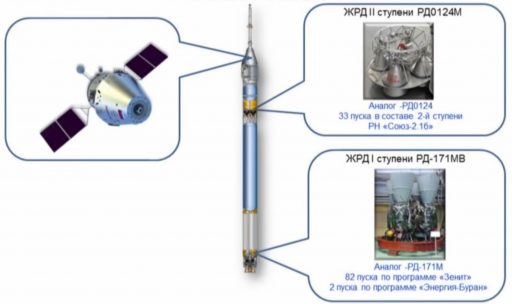
A major change from Zenit to Soyuz-5 is a widening in diameter from 3.9 to 4.1 meters to increase the volume of its tanks as the main contributor to the desired LEO performance increase from 13.7 to 17 metric tons. The 4.1-meter diameter is the widest possible for rail-transport of the launch vehicle from its production plant in Samara to the Baikonur Cosmodrome. However, looking at future prospects of launching Soyuz 5 from Vostochny, there would be a number of bottlenecks in getting the vehicle to the Far Eastern spaceport by rail.
Soyuz-5 – given its similarities with Zenit – can also be flown from the Sea Launch Platform without too extreme modifications to existing ground support hardware. Another element of the Soyuz-5 design is its first stage building the basis for a strap-on booster for a future Super Heavy-Lift Launch Vehicle set to fly at some point in the second half of the 2020s.
The differences between Soyuz-5 versions planned to be launched from the Baitarek Cosmodrome (Zenit complex at Baikonur), the Sea Launch Platform and eventually the Vostochny Cosmodrome would be limited to the Ground Support Equipment interfaces.
The Long Story of How Soyuz-5 Came About
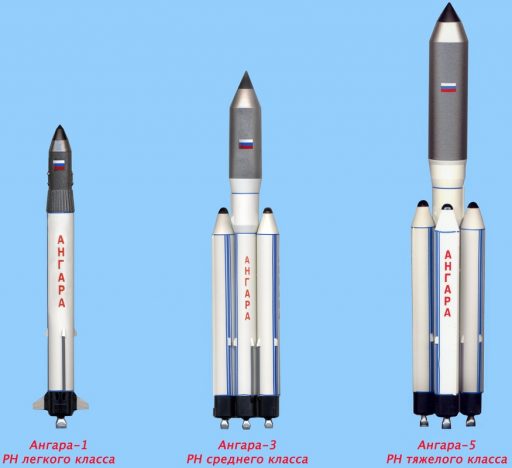
The story of Soyuz-5 essentially goes back to the early 1990s when, after the fall of the Soviet Union, Russia was looking to re-organize its space program with the ultimate goal of replacing its current line of rockets and crew spacecraft with modern-day technology. The primary concern, however, was the reliance on the Baikonur Cosmodrome in the now independent nation of Kazakhstan. The result was Angara – a family of modular rockets covering the entire spectrum of missions and capable of delivering sizeable satellites to all kinds of orbits from Russian territory.
Angara was officially approved as an all-Russian launcher in 1992, but spent the rest of the 90s on the drawing board going through numerous design iterations before rocket builder Khrunichev settled on a preliminary design in 1999. However, it would take more than a decade to actually move from a concept to the launch pad as a seemingly endless string of delays plagued the project due to technical challenges and limited funds. Two versions of Angara successfully flew in 2014 but putting the vehicle into serial production turned out to be another time-consuming endeavor with no operational vehicle in sight as of 2018.
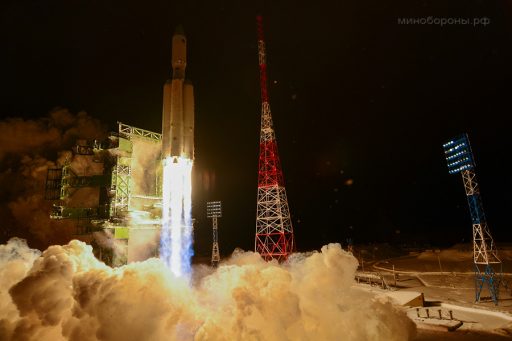
It was likely these persistent delays that prompted Roscosmos to opt for a completely new rocket to orbit their upcoming Federatsia PTK spacecraft. This brand new rocket, called Rus-M, was presented in 2009 to be designed and manufactured by TsSKB Progress which brought plenty of experience to the table by virtue of decades of successful production of the Soyuz rocket family. The Rus-M concept called for a modular rocket design that can be sized for a LEO capability of 6.5 to 50 metric tons.
Rus-M was shelved in 2011 when it became clear that Russia would not have the money to support two heavy-class orbital launch vehicles. As a result, Federatsia was shifted from Rus-M to Angara-A5P – a human rated version of the Anagara-A5 which, with this new role, was also to get a launch pad at the Vostochny Cosmodrome.
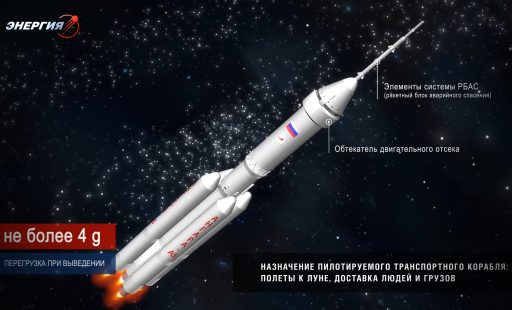
However, Angara was not an ideal fit for Federatsia: The rocket’s performance did not quite match up with predictions, requiring its RD-191 engines to be up-rated and a new cryogenic upper stage would be necessary for sending Federatsia beyond Low Earth Orbit and even then, no less than four vehicles would be required to assemble all the hardware needed for a crewed mission to the lunar surface.
The high cost of Angara, the difficulty encountered with moving it into operational production and the schedule uncertainty surrounding the Vostochny launch complex contributed to another change in direction by Russia’s leadership. Following a May 22, 2017 meeting between space officials and policy leaders – including President Putin – it was announced that Federatsia would be launching on Soyuz-5, a Kerosene-fueled, modern-day version of the Zenit rocket.
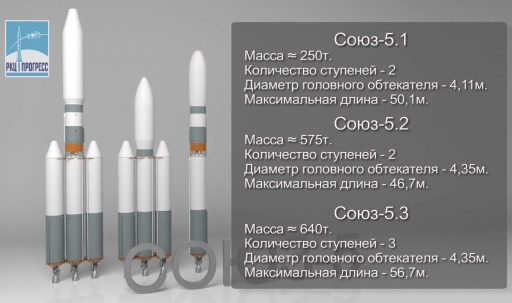
This announcement caused some confusion as a vehicle going by the same name had been presented by TsSKB Progress back in 2013 as a methane-fueled rocket as an eventual replacement for the Soyuz fleet. Initially starting out as an internal study for a scalable, methane-fueled launch vehicle, the project received some funding under a Roscosmos research program named ‘Feniks’. The baseline version of the vehicle was a two-stage LOX/LNG rocket powered by a 3,300-Kilonewton RD-0164 on the first stage and a 740kN RD-0169 on the second stage for a total LEO capacity of 9 metric tons – suitable for launching Soyuz-class spacecraft into Low Earth Orbit. A more powerful version would strap three first stage cores together to lift up to 16t into orbit.
The project appeared to be advancing through its next stage of detailed technical specification analysis and was expected to be awarded a contract for actual development work in the 2017/18 time frame. However, by late 2015, reports began emerging in Russian press outlets that Roscosmos opted for a different vehicle to be developed under the ‘Feniks’ program, detailing a target LEO capacity of 17 metric tons. The timing of this decision coincides with two November 2015 meetings involving Russian space program leaders and Vladimir Putin.

In early 2016, the contract for Feniks appeared up for competition among RSC Energia, TsSKB Progress and Khrunichev. Energia had studied designs for an all-Russian Zenit-equivalent since 2010/11 – replacing any foreign parts on Zenit with Russian hardware and modernizing components designed in the 1980s to create a cost-effective launch vehicle that would not rely on any outside materials. This new launch vehicle was announced as “Sunkar,” Kazakh for Falcon, and RSC Energia was given the role of prime contractor with TsSKB Progress and Khrunichev as subcontractors for launch vehicle integration and component manufacture, respectively.
Sunkar remained a ‘paper rocket’ through 2016 and outside observers had no real way of telling which of the proposals made for Feniks, Sunkar and other vehicles stood the best chance of actually seeing flight. This changed on the May 22, 2017 when, under Putin’s direction, Federatsia was switched from Anagara-A5V to Sunkar which in turn was re-christened Soyuz-5 while the former Soyuz-5 proposal of TsSKB Progress was changed to the name of Soyuz-7.
Some confusion remains on how the decision to opt for Energia’s vehicle was made. Leading up to the May 2017 meeting, discussions were reported within the Russian space sector that Federatsia was likely to move away from Angara. However, Russia’s TsNIIMash research and development institute warned that such a move would likely delay the first Federatsia flight by several more years. Interestingly, TsNIIMash apparently had a major change of heart only days before the meeting when a statement was issued stating development of the new rocket could be completed in time for Federatsia’s current schedule due to the high-degree of commonality with the proven Zenit rocket.
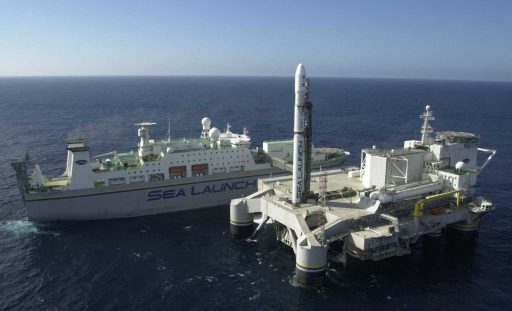
After the decision became public knowledge, space officials said the new rocket could also fly from the Sea Launch Platform (now in the hands of S7 Group). The initial flights of the rocket are expected from the Baikonur Cosmodrome, utilizing the existing Zenit infrastructure at Site 45/1. Plans as of 2017 called for Soyuz-5 to reach the launch pad in 2022 and carry out its first crewed mission in 2024.
One element in keeping to this expedited development schedule appears to be foregoing some of the bureaucratic elements typically involved in projects such as this. To that end, RSC Energia appears to have been officially selected as the program’s prime contractor in August 2017 without going through a competitive contracting process. Energia was only given half a year to complete the preliminary design stage for Soyuz 5 by March 31, 2018 – in part enabled by design work that started back in 2010.
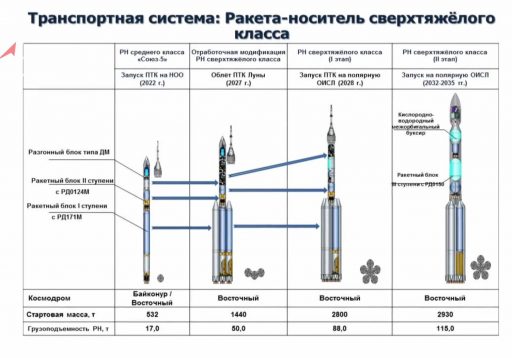
Roscosmos presented the approved preliminary design for Soyuz-5 to the public on April 11, 2018 – adding credence to Soyuz-5 being Russia’s most serious attempt to create a vehicle actually capable of lifting off the drawing board.
However, less than a week later came the next major flip when Russian Deputy Prime Minister Dimitry Rogozin stated that there will be a study of fitting Soyuz-5 with a Methane-fueled engine. According to Rogozin, development of a medium-lift solution such as Soyuz-5 should be placed on the backburner in favor of a more forward-looking design that could become a replacement for Angara.
The study of switching Soyuz-5 back to methane was to be completed within three month’s time. (Presented on this page is the preliminary design for Soyuz-5; a switch back to methane-fueled engines can be considered a separate LV design.)
All Russian Hardware
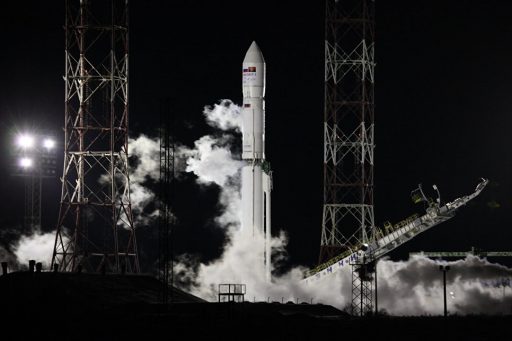
Reliance on foreign nations has been a problem for Russia as seen by the downfall of the Zenit project due to the conflict with the Ukraine and the continued dependence on the Baikonur Cosmodrome is not expected to end any time soon. Additionally, sanctions imposed on Russia from the West made procurement of a number of components difficult for their current line of rockets. Understandably, there was great desire in creating an all-Russian rocket that can be manufactured with zero foreign components.
Russia stated repeatedly that around 75 to 85% of Zenit’s components were built in Russia, but as outlined above, Soyuz-5 is far from a twin to Zenit – requiring new tooling for the larger stage diameter and modified ground support equipment interfaces. Also, a number of Ukrainian parts, like the second stage’s RD-120 engine and flight control components, have to be replaced by Russian hardware.
On the other hand, production of many Zenit parts had ended as the vehicle ended regular operations including the production line for the RD-171M engine at manufacturer NPO Energomash. The only component of Soyuz-5 that was already available in serial production was the RD-0124 engine of the second stage and even that will require modifications for Soyuz-5.
First Stage
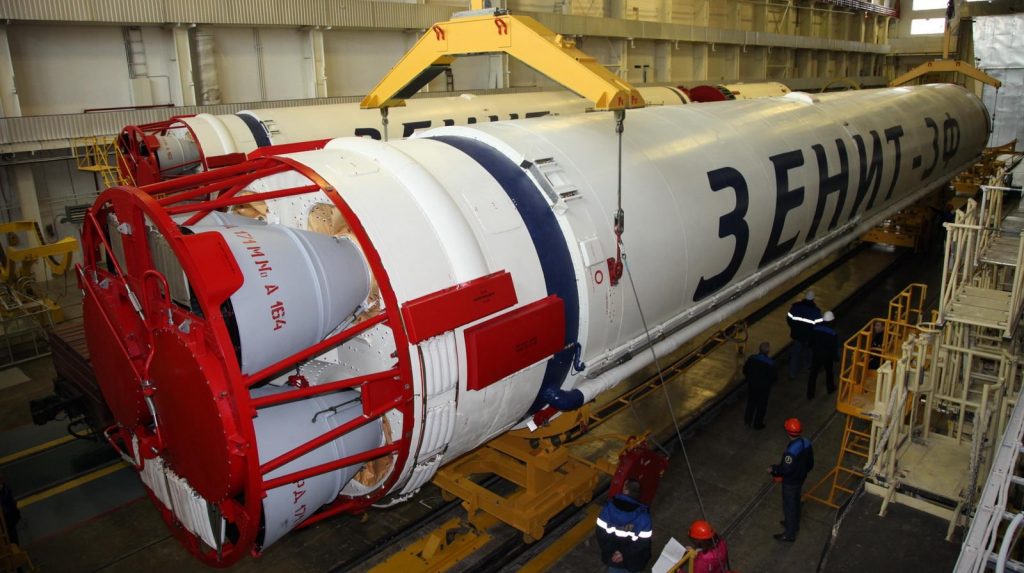
| Type | Soyuz-5 First Stage (Zenit Heritage) |
| Length | 37.14 m* |
| Diameter | 4.1 m |
| Inert Mass | 30,500 kg* |
| Launch Mass/Fueled | 430,500 kg* |
| Fuel | Rocket Propellant 1 |
| Oxidizer | Liquid Oxygen |
| Fuel Mass | 110,000 kg* |
| Oxidizer Mass | 290,000 kg* |
| Material | Aluminum, Stiffeners |
| Guidance | From 2nd Stage |
| Propulsion | 1 x RD-171MV |
| Engine Type | Staged Combustion |
| Propellant Feed | Turbopump |
| Comb. Chambers | 4 |
| Total Thrust SL | 7,257 kN** |
| Total Thrust Vac | 7,904 kN** |
| Engine Length | 4.15m** |
| Engine Diameter | 3.57 m** |
| Engine Dry Weight | <9,300kg |
| Nozzle Ratio | 36.87** |
| Thrust-to-Weight | >82 |
| Burn Time | 180 sec* |
| Specific Impulse | 309 sec (SL) 337 sec (Vac)** |
| Chamber Pressure | 245 bar** |
| Throttle Capability | 56%-100%** |
| Engine Start | Hypergolic |
| Restart Capability | No |
| Ox to Fuel Ratio | 2.63 |
| Attitude Control | Gimbaled Engine (Pitch, Yaw, Roll) |
| Max Gimbal | 6.3 deg |
| * Original Sunkar Concept (Soyuz-5 likely higher) | |
| ** Operational Characteristics of RD-171M | |
The first stage of the Soyuz-5 rocket can be considered a widened and stretched version of that flown on the Zenit rocket, retaining the overall architecture of its ground interfaces and RD-170-derived main engine. Increasing the stage’s diameter from 3.9 to 4.1 meters and stretching it by close to four and a half meters yields an increase in propellant mass on the order of 20% at only a marginal increase of the stage’s dry mass due to the use of modern manufacturing techniques optimized for mass reduction.
The first stage employs the conventional design of locating the Liquid Oxygen oxidizer tank above the Kerosene fuel tank and routing the LOX feedline through the center of the RP-1 tank. One critical element of the first stage design is a narrower diameter of the engine section at 3.68 meters, structurally identical to the Zenit rocket to provide the necessary compatibility with the existing ground support systems with respect to the structural attachment to the launch mount as well as commodity lines to the rocket.
Per the original Sunkar/Soyuz-5 proposal, the first stage was to stand 37.14 meters tall with a dry mass of 30,500 Kilograms and a propellant capacity of 400 metric tons. These numbers have liked trended up slightly as the vehicle evolved into its preliminary design, though no specifics have been published.
The Soyuz-5 first stage is powered by a single NPO Energomash RD-171MV engine, a modified version of the RD-171M used on the Russian-Ukrainian Zenit rocket which in turn was an upgraded variant of the RD-170 engine developed between 1976 and 1987 for the Soviet Energia rocket that only flew twice in 1987 and 1988. To this day, the RD-170 line remains the most powerful rocket engine ever built in terms of total thrust generated (but not for thrust to weight ratio for which SpaceX’s Merlin 1D++ holds the leading position).
RD-170 followed a design the Soviets pursued since the earliest days of space flight, feeding multiple combustion chambers from a common set of turbopump equipment. In the beginning, this was not by choice but by necessity as high-thrust, single-chamber engines suffered from excessive thrust instability problems. (The U.S. F1 engine, to this day the most-powerful single-chamber, liquid-fueled engine also had its fair share of thrust instability problems that were eventually overcome by a baffled injector design).
Two versions of the engine reached the launch pad in the 1980s: the RD-170 flew on the two Energia flights while the RD-171 began powering the Zenit rocket in 1985. While sharing the same performance characteristics, the engines employed different structural systems to fit their respective launchers and differed in their thrust vector control systems. The RD-170 employed single-axis gimbaling of its four nozzles due to its role as a strap-on booster while the RD-171 employed two-plane gimbaling to allow a single engine unit to provide three-axis control.
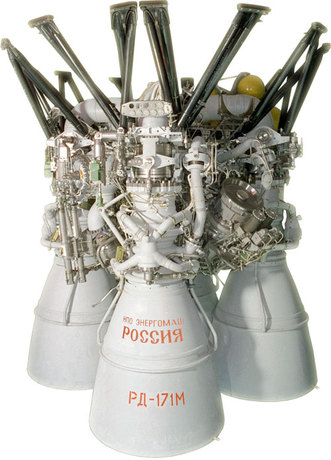
A performance-enhancement of the RD-171 was studied in the 1990s and realized in 2003/04, up-rating the engine to operate at 105% of the original engine’s performance and reducing its dry weight by eliminating unnecessary structural elements to further improve the engine’s thrust-to-weight ratio. This engine, called RD-171M by its manufacturer (sometimes also known as RD-173) debuted on the Zenit rocket in 2006.
Descendants of the RD-170/171 engine have made it one of the most wide-spread power units in the rocket industry. The dual-chamber derivative, RD-180, has been used very successfully since 2002 on the Atlas III and Atlas V rockets with an almost spotless service record (only one in-flight anomaly that remained without consequence). Single-chamber versions of the engine build the foundation of the Angara rocket series (RD-191), are exported to the U.S. to power the upgraded Antares 200 series (RD-181), and will eventually replace the NK-33 engine of the Soyuz 2-1v once its inventory runs out (RD-193, a re-packaged version of the 191). Another derivative, the RD-151 with reduced thrust, was flown on the South Korean Naro-1 rocket.
The RD-171MV engine development program has the overall goal of re-creating the performance characteristics of the RD-171M using only Russian components and introducing modern-day manufacturing techniques to make the engine lighter and so enhance its overall performance. RD-171M relied on a Ukrainian hydraulic pump assembly (BIM) for its gimbaling system while the engine controller included components imported from the West and no-longer available under Russian sanctions.
NPO Energomash said the RD-171MV will be their first engine to be solely designed through 3D software which is expected to streamline the design process and ease its transition into production as the 3D models can be used for multi-axis machining and 3D printing of engine components. The use of these modern production techniques will reduce production cost and provide a performance enhancement by reducing engine dry mass which will make RD-171MV more efficient than its predecessor.
NPO Energomash also said it was studying four-chamber RP-1/LOX engine designs capable of delivering close to 1,000 tf of thrust.
Second Stage

| Type | Soyuz-5 Second Stage |
| Length | 7.8 m* |
| Diameter | 4.1 m |
| Inert Mass | 6,500 kg* |
| Launch Mass/Fueled | 71,500 kg* |
| Fuel | Rocket Propellant 1 |
| Oxidizer | Liquid Oxygen |
| Fuel Mass | 19,500 kg* |
| Oxidizer Mass | 45,500 kg* |
| Tank Material | Aluminum |
| Guidance | Inertial |
| Propulsion | 2 x RD-0124M |
| Engine Type | Staged Combustion, Closed Cycle |
| Propellant Feed | Turbopump |
| Comb. Chambers | 2 x 4 (Circular Arrangement) |
| RD-0124A Thrust Vac | 294.3 kN |
| Total Thrust | 588.6 kN** |
| Specific Impulse | 359 sec** |
| Engine Length | 1.575 m** |
| Engine Dry Weight | >548 kg |
| Nozzle Ratio | 36.87** |
| Burn Time | 390 sec* |
| Chamber Pressure | 245 bar** |
| Throttle Capability | 56%-100%** |
| Engine Start | Pyrophoric Injection |
| Restart Capability | No |
| Ox to Fuel Ratio | 2.34** |
| Turbine Temp. | 973 K** |
| RD-0214 Ox Flowrate | 56.7 kg/sec** |
| RD-0214 Fuel Flowrate | 23.9 kg/sec** |
| Turbine Inlet | 319 bar** |
| Turbine Outlet | 185 bar** |
| Attitude Control | Chamber Gimbaling +/-3.5°** |
| * Original Sunkar Concept (Soyuz-5 likely higher) | |
| ** Operational Characteristics of RD-0124A | |
The second stage of the Soyuz-5 rocket shares the first stage’s 4.1-meter diameter and is around eight meters in length, powered by a pair of RD-0124M engines with a total of eight nozzles. As part of the Sunkar design study, evaluations were made whether it was possible to fit an existing second stage like that of the Soyuz 2 or Angara on the vehicle, though the desired performance was not achievable with existing hardware.
Creating a Zenit-derived second stage with only Russian hardware was somewhat more complex since the RD-120 main engine and RD-8 steering vernier were both designed and produced in the Ukraine. A comparable LOX/RP-1 engine for use on a vacuum-optimized stage did not exist in Russia and required the RD-0124A engine of Angara (which itself is derived from the RD-0124 of Soyuz-2) to be modified to allow two four-chamber engines to be arranged to fit under a 4.1-meter diameter rocket stage.
The original Sunkar/Soyuz-5 concept called for the second stage to be 7.8 meters long with a dry mass of 6.5 metric tons and a propellant capacity of 65 metric tons (changes through the preliminary design of Soyuz-5 likely resulted in a further enlargement of the second stage). Compared to Zenit, the second stage is two metric tons lighter (inert mass) and two and a half meters shorter, in part due to a shorter engine section given the use of eight smaller chambers/nozzles compared to the tall vacuum-expanded RD-120 nozzle.
RD-0124 was developed by the KBKhA Design Bureau (since 2015 part of Energomash) as a higher-performance version of the RD-0110 engine that has been powering the Block I stage of the Soyuz and Molniya rockets since its inauguration in 1965. The switch to closed-cycle engine technology and four gimbaling main chambers (eliminating four steering verniers) provided an increase in combustion efficiency, increasing the specific impulse by 10%. The RD-0124A version developed for Angara did not change the performance characteristics of the engine but reduced its dry weight by 24 Kilograms and certified it for a longer burn time of 424 seconds (vs. 300 sec on Soyuz).
The RD-0124M version takes the RD-0124A and re-packages its structure to allow the eight chambers/nozzles to take a circular arrangement to provide an optimized transfer of thrust force into the load-carrying structure of the vehicle, eliminating some of the elements needed to support the 2×2 arrangement. RD-0124M retains the performance characteristics of the RD-0124A version.
Some confusion with the exact naming convention arose as an earlier KBKhA proposal floating around in the late 1990s for a single version of the RD-0124 gave it the name RD-0124M. Additionally, information provided in 2017 by TsSKB Progress identified the engine for Soyuz-5 as RD-0124MS. However, in the presentation of the preliminary design from late 2017 forward, the engine was only called RD-0124M.
Third Stage
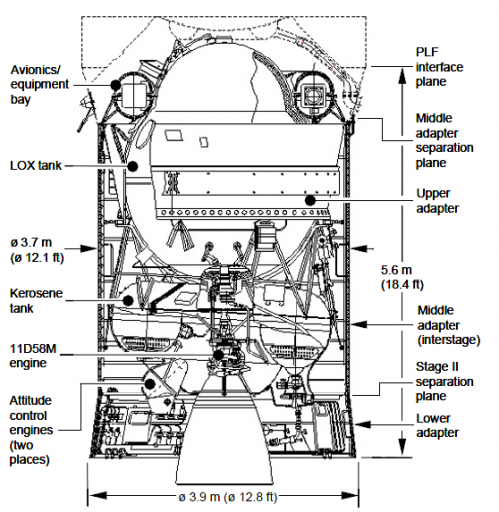
To reach a variety of orbital destinations, Soyuz-5 can be fitted with different upper stages, much like the other Russian rockets like Soyuz and its Ikar & Fregat upper stages, Proton and its Briz-M & Block DM-03 or Zenit and its Fregat-SB & Block DM-SL. These stages provide multi-burn mission capability over an extended duration to allow for injection capacity directly into Medium Earth Orbit, Geostationary Transfer & direct-to-GEO, and interplanetary injections.
Given RSC Energia’s role in the Soyuz-5 project, the baseline upper stage (called by its Russian acronym RB) will be the company’s Block-DM-SLB. According to the preliminary design of Soyuz-5, the goal was to use the upper stage with a minimum of modifications to keep costs down. A second option for upper stage is NPO Lavochkin’s Fregat-SB (inherited from Zenit) or a Fregat version with additional propellant capacity.
The baseline Sunkar proposal, when employing Block-DM-SLB, had a target performance of 5.0 metric tons into a standard Geostationary Transfer Orbit and 2.5 metric tons for a direct-to-GEO insertion.
Payload Fairing
The baseline payload fairing for Soyuz-5 will be provided by Khrunichev in cooperation with NPO Lavochkin. According to the preliminary design requirements documentation that was made public, Soyuz-5 was to use the payload fairing design of the Angara A5 rocket for which three different fairing designs exist depending on the type of upper stage that is being flown, varying from 4.35 to 5.1 meters in diameter and 7.75 to 15.9 meters in length. An additional requirement outlined for Soyuz-5 was to keep compatibility with the former Sea Launch Payload Fairing built by Boeing.
